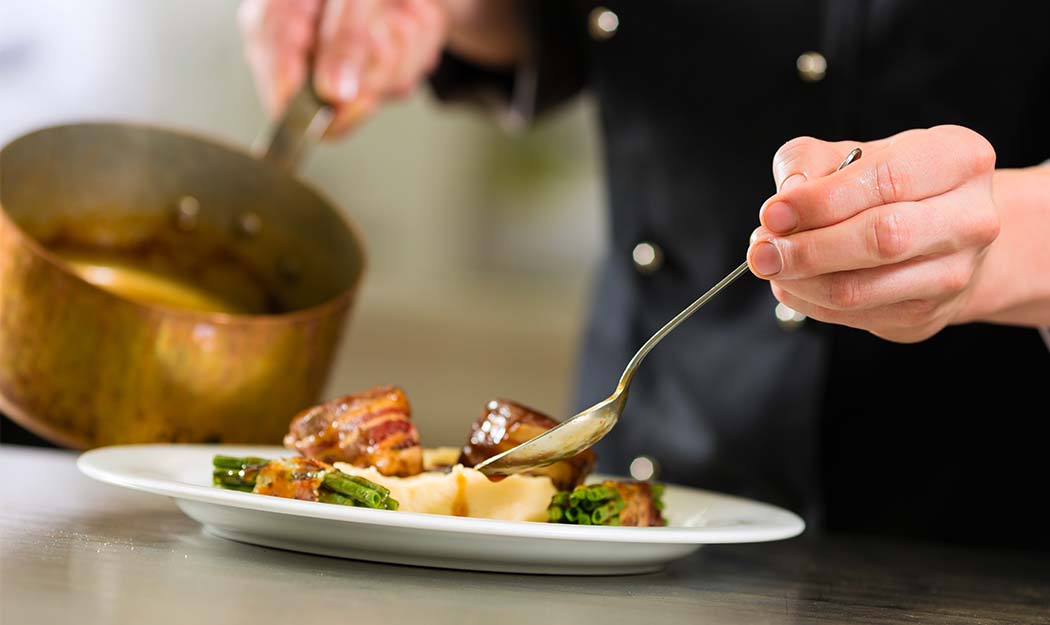
It is important that you can create a simple yet effective checklist of cooking skills for your children. These skills range from developing creative recipes to ensuring that the kitchen is safe. These skills are vital for your child's development. Here are some tips. Here's a sample checklist:
Here are some essential culinary skills
To be a chef, you must have a solid understanding of how to prepare good food. These skills include the ability to identify freshness, prepare meats, fruit, and vegetables, as well as convert standard recipes into larger batches. A chef must be proficient in time management, as well as a keen sense of smell and taste. A chef should also be able handle knives and other food equipment.
Sauteing, a versatile cooking technique, can be used for many ingredients. Lightly sauteed vegetables and shrimp in garlic butter are particularly delicious. Braising, which is one of the oldest cooking methods, involves boiling over an open fire. Although it is not a very advanced skill, it is still extremely useful. If you can boil a dish, you are on your way to becoming a good cook. It is also important to know how to use a knife and understand safety tips.
Developing creative recipes
Creativity is key to success when preparing meals. These creative recipes are not only a showcase of your creativity but also a showcase of your skills. Divergent thinking, also known as creative thinking, is a way to think outside the box and come up with new ideas. This is an important skill for a cooking career, because it allows you to experiment with different flavors and cooking techniques and impress your customers. Employers will appreciate your creative thinking and the ability to create new recipes. Try different combinations of flavor, and come up with interesting themes for the meals. Try brainstorming and researching cooking methods to improve your creativity.

The problem with cooking skills is their inconsistent definitions. While they disagree about which one is most important, the authors agree that the definition of the skill needs to change. They argue that the definition of a skill should be evolved from the perceived "Golden Age" when cooking skills were developed beyond a person's ability to prepare basic foods. To ensure a healthy and vibrant future of food, we must encourage their development and use.
Developing a safe environment in a kitchen
It is crucial to create a safe working environment in your commercial kitchen for your employees' health. The kitchen can be a potentially dangerous place with electrical appliances, bacteria, and an open fire in the oven. It is important to create a plan for cleaning the kitchen and use safety equipment. Also, make sure that children are supervised in the kitchen. Properly training employees and implementing a safety plan can go a long way to preventing accidents.
All kitchen staff should be certified in fire-resistance or fire-safety. Fire-safety training is available through local fire authorities. It is important that kitchen staff know where fire extinguishers or fire blankets are located, how they operate, and how to manually activate the fire-suppression systems. It is also a good idea to train employees in CPR/first aid. Kitchens should be equipped with non-slip flooring or mats whenever possible.
Identification of food safety hazards
You must identify food safety hazards before you prepare any meal, or cater for special occasions. It is essential to identify possible hazards when preparing food. Failure to identify potential hazards could lead to brand damage, regulatory action, and even brand destruction. Codex HACCP compliance is crucial for food businesses, and identifying hazards is a fundamental requirement.

There are many potential physical hazards that can inflict injury on humans. These hazards can be either natural or artificial, and they can come from plants or people. Different physical hazards can cause injury or disease differently. These hazards may not be inherently dangerous. But they must be detected and eliminated before they can cause any harm. To identify potential hazards, identify the source of the risk and determine how to minimize it. You can also examine the product to determine the source.
FAQ
How do I become a Chef?
There are many avenues to become a professional chef. Begin by enrolling at a community college. Next, consider attending culinary school. Finally, you can take a paid internship.
Can I learn to cook alongside my kids?
Yes! Yes! Kids love helping in the kitchen. It's a great way to teach responsibility and teamwork. Children can help in everything, from washing vegetables and cutting onions. They will enjoy helping you to cook if your children are safe with knives.
How do I get motivated to cook?
Sharing food with friends and family is a great way to have fun cooking. Cooking for your own family is much easier than making meals for others. If you want to be motivated to cook, try making something new. You will be able to learn new techniques and ingredients. To expand your culinary skills, you can also make use of recipes from other cultures.
What are the benefits to using a slow cooker
Slow cookers can be very helpful because you can prepare delicious meals quickly. Slow Cooker Recipes are often healthier than traditional recipes because they require less oil and fat. Also, slow cooker recipes are easy to use because they do all the work while you sleep.
Is there any special equipment that is required to cook?
It doesn't take any special equipment or tools to learn to cook. However, having the right tools can make cooking easier. You could, for example, use a spoon to make pasta or a whisk to whip the egg whites into stiff peaks. It makes cooking much easier and quicker.
What is the average time it takes to learn how to cook? What time do you need to learn how to cook?
It depends on the skill level. Some people are able to learn basic cooking skills in a matter of days. Others may take several months or longer to feel competent enough to teach themselves how they cook.
There are many factors that affect the time required to learn how cook. Someone who has never been to the kitchen before might need more time than someone who does it regularly. Some types of cooking are more difficult than others. Baking is more difficult than frying.
A specific technique will help you cook faster. You can then move on to the next technique once you have mastered it. Don't worry too much about the exact number of days or weeks it takes to learn to cook. Just keep practicing and enjoy the process.
Statistics
- under 10 Kids have been taught that there is special food just for them, and Fiese says that 10 percent of kids will throw a tantrum if they don't get the food they want. (washingtonpost.com)
- In the United States, the category is estimated at $23.2 billion annually and is growing faster than the market. (washingtonpost.com)
- On average, chefs earn $58,740 a year, according to the BLS. - learnhowtobecome.org
External Links
How To
How to make a perfect omelet
Omelets is one of my favourite breakfast foods. But how do they turn out so perfectly? I've tried many recipes and different methods but none have worked. So today, I want to share some tips and tricks with you so you can make your own delicious and fluffy omelets every morning.
We should first know that eggs are very temperamental ingredients when making omelets. The eggs must be fresh from an organic source and kept at room temperature until they are ready to be cooked. They must be kept cool, otherwise the whites will not form properly and the yolks may become runny. This causes your omelets to look oddly colored. If you're going to cook them immediately, it is best if the eggs are still warm.
Another tip is to separate your egg before adding it into the pan. You don't want the white to get mixed with the yolk, as this could cause the egg to curdle.
You might burn the bottom of the egg if you place the egg directly on the stovetop. This could ruin the texture of your omelet. Instead, place the egg in the microwave for 10 second before you put it in the skillet. The microwave heat cooks your egg just right, without it becoming too soft.
Next, let us talk about how to mix the eggs. Mixing eggs together is important. You need to beat them well. To do this, take the bowl from the mixer and flip it upside-down. Then, vigorously shake the bowl. This way, the air inside the bowl gets whipped around and mixes the egg thoroughly.
The fun part begins - you need to pour the milk into your mixture. First, pour half of the milk into the beaten eggs and then fold the eggs gently into the remaining milk. If you still see streaks of eggs, don't worry. These streaks will disappear once the omelet has been turned over.
After folding the eggs, place the pan on medium heat and wait for the oil to start sizzling. Once the oil starts getting hot, add 1/4 cup of butter to the pan and swirl it around to coat the entire surface of the pan. Open the lid and sprinkle salt on the pan. A pinch of salt will prevent your omelet from sticking in the pan.
Once the omelet has formed completely, cover the pan and let it set for a few minutes. Use a spatula to flip the omelet or turn the pan upside-down. Cook the other side for another minute or two. Serve immediately after removing the omelet from its pan.
This recipe is best made with whole milk. However, it can also be used with skimmed milk.